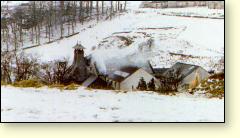
Location: Keith, Banffshire
Roads: Turn off the A96 by the Union Bridge
Phone: 01542-882295
|
During the whisky boom of the 1880s and 1890s, distillers looking to expand production and entrepreneurs trying to get some of the action snapped up disused and derelict mills of all sorts for conversion into distilleries.
Strathmill distillery in its original form was a flour and corn mill that had operated on its site since early in the century. Coincidentally it was constructed in 1823 when the freedoms of the new Excise Act set in motion an earlier distillery-building boom. According to a batch of contemporary local newspapers that were embedded with the foundation stone of the whisky-making installations, there had also been a distillery on the spot in the 1820s. It was probably part of the mill operation, added in the wake of the 1823 Act.
Seen from the banks of the stream, the twin pagoda roofs of the kilns and the zigzag lines of the warehouse gables are delightfully evocative of their era. The cornmill’s whisky-making role was established in 1891 and the distillery called Glenisla-Glenlivet. It was the done thing at the time for distilleries to attract a little more attention to their product by hyphenating the celebrated but already-protected Glenlivet name with their own. Just four years later Glenisla was sold to W. & A. Gilbey of London, who changed the name to Strathmill.
There are two pairs of stills, the second pair dating from 1968. The spirit stills have purifiers on the lyne-arms to lighten the spirit. The River Isla only supplies the water for cooling; the water to make the whisky comes from a spring in the grounds.
The Whisky
Strathmill is light, gently fragrant of malt and keen fruit, and finishes smoothly with only slightly peaty zest. It was previously obtainable as a self whisky but all the make now goes to blending, particularly for the J & B and Dunhill ranges.
Source of water
Local wells